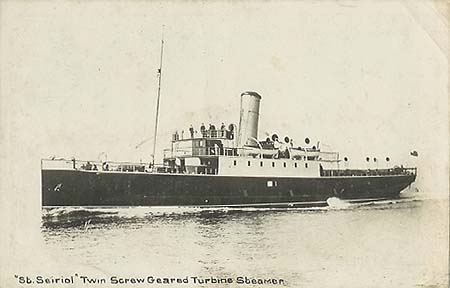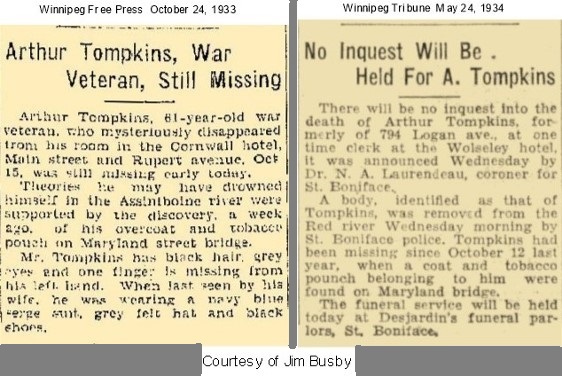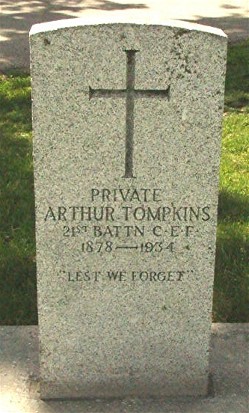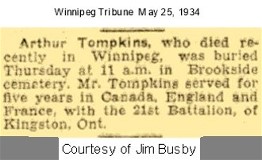|
Jun 20, 1872
|
Born in England
Arthur married Ellen Payne in Wellingborough,
Northamptonshire, England in April, 1893
|
|
Nov 14, 1914
|
Attested into the 21st Battalion in
Kingston, Ontario
Ø Number 59993 (temporary number
1120)
Ø Next of kin given as Ellen
Tompkins, wife, 59 York Road, Erdington, England
Ø Previous occupation given as
Bootmaker
Ø Previous military experience
given as North Hampshire Regiment
Ø Religion given as Church of
England
Ø Posted to the Base Unit
o
Employed
in the Transport Section
Arthur Tompkins lied about his age on attesting, stating he was
born in 1878, not his actual birth year of 1872
The 21st Battalion trained in the Kingston, Ontario
area through the winter of 1914-15.
|
|
Mar 1, 1915
|
Ceased to be employed in the Transport Section
and now employed as Shoemaker Assistant with extra working pay
|
|
May 6, 1915
|
Embarked the RMS Metagama in Montreal, Quebec

|
|
May 15, 1915
|
Disembarked in Devonport, England and the
battalion proceeded to the West Sandling Camp, near Hythe, Kent to continue
training
|
|
Jul 14, 1915
|
Promoted to rank of Sergeant and appointed
Sergeant Shoemaker and posted to Battalion Headquarters Staff
|
|
Sep 2, 1915
|
Posted to “B” Company and employed in the
Quartermaster Section
|
|
Sep 14, 1915
|
Embarked the St. Seiriol in Folkestone

|
|
Sep 15, 1915
|
Disembarked in Boulogne, France and the battalion
proceeded to St. Omer
|
|
Feb 9, 1916
|
Granted 9 days leave
|
|
Feb 21, 1916
|
Rejoined the battalion resting in La Clytte, Belgium from leave
|
|
Jul 28, 1916
|
Granted 10 days leave
|
|
Aug 9, 1916
|
Rejoined the battalion in the front lines near
Voormezeele, Belgium from leave
|
|
Jul 28, 1917
|
Granted 10 days leave
|
|
Jan 1, 1918
|
Entitled to 50¢ per day working pay as Shoemaker
|
|
Feb 18, 1918
|
Granted 14 days leave
|
|
Mar 5, 1918
|
Rejoined the battalion at the front just outside
Lens, France
|
|
Dec 13, 1918
|
The 21st Battalion crossed the Bonn
Bridge to enter Germany as part of the Occupying Force and proceeded to
Seigburg, Germany

|
|
Jan 17, 1919
|
Granted 14 days leave
|
|
Feb 13, 1919
|
Rejoined the battalion in Ham sur Sambre, Belgium
from leave
|
|
Feb 27, 1919
|
Admitted to the No. 6 CFA (Canadian Field
Ambulance) with a diagnosis that reads Jaundice. He was transferred the same day to the No.
53 CCS (Casualty Clearing Station)
|
|
Feb 28, 1919
|
Transferred to the No. 48 Casualty Clearing
Station
|
|
Mar 4, 1919
|
Transferred to the No. 53 General Hospital in
Camiers, France
|
|
Mar 27, 1919
|
Invalided to England and admitted to the No. 16
Canadian General Hospital in Orpington
Transferred to the Eastern Ontario Regimental
Depot for pay purposes while in hospital
|
|
Jun 28, 1919
|
Fitted with dentures after having all his teeth
extracted
|
|
Sep 11, 1919
|
Embarked the Hospital Ship Araguaya

|
|
Sep 19, 1919
|
Disembarked in Halifax, Nova Scotia and proceeded
to Kingston, Ontario
|
|
Sep 21, 1919
|
Admitted to the Sydenham Street Military Hospital
in Kingston with boils on face and tender liver and gall bladder
|
|
Sep 22, 1919
|
Granted leave until October 6, 1919
|
|
Sep 29, 1919
|
His leave was cancelled when he was admitted to
the Queen’s University Hospital in Kingston with Jaundice
|
|
Dec 23, 1919
|
Medical exam in Kingston notes
Ø Suffers from general weakness
following Acute Catarrhal Jaundice
Ø Is poorly nourished and
complains that he is unable to chew solid food because of ill fitting
dentures
Ø Has multiple scars and boils
over neck, back, arms and legs
Ø Has lost over 20 lbs and tires
easily
Ø Man is unfit for military
service and should be discharged to the care of the SCR (Soldier Civil
Re-establishment) Department for continuing care
|
|
Dec 31, 1919
|
Discharged from the CEF in Kingston, Ontario
Ø Rank on discharge Sergeant
Ø War Service Badge Class “A”
issued number 214968
Ø War Service Badge Class “B”
issued number C65478
Ø Proposed residence on
discharge 59 York Road, Erdington, Birmingham, England
Ø Discharged into the care of
the SCR (Soldier Civil Re-establishment) Department
Following his discharge, the 1914-15 Star,
British War Medal and Victory Medals were sent to him at 40 Harrison Road,
Erdington, Birmingham, England in 1921.
|
|
Jul 20, 1932
|
Married to Hilda Marion Barker in Winnipeg,
Manitoba
No date for his return to Canada from England,
nor a resolution of his first marriage has been found.
|
|
Oct 15, 1933
|
Arthur Tompkins was reported as missing. He had not been seen since October 12th
and personal items of his were found on the Maryland Street Bridge in
Winnipeg and it was feared that he had drowned
|
|

|
|
May 23, 1934
|
Arthur Tompkins’ body was recovered from the Red
River and positively identified. He was
buried in the Brookside Cemetery, Winnipeg, Manitoba.

Interestingly, both the year of birth and year of
death are incorrect on the grave marker.

The Department of Vital Statistics in Manitoba
record his death as November, 1933 without listing a day
|
|
Arthur Tompkins’ death was reported to Veterans
Affairs Canada by his widow, Mrs. Hilda Tompkins, Suite 6, Douglas Block, 366
Graham Ave., Winnipeg, Manitoba. She
reported his date of death as “about October or November, 1933”. This was later changed to read October 15,
1933
|
|
The following is a conclusion drawn by Jim Busby,
a military historian living in Winnipeg, Manitoba:
“I'm
thinking suicide. First, the Maryland Bridge was a long way from where
he lived. That suggests some kind of planning and not an
accident. There was then and still is a hospital on the north side of
the river there, (Misericordia). The banks of the Assiniboine at that
location do not encourage easy entry. If he wanted to just walk into
the river, the banks of the Red are a much easier wade in, and also
a lot closer to his home. I think he went over the side of the
bridge. The river is not deep there, but the current is fast. I'm
guessing he hit the bottom and died from the fall. The
current then carried him out to the Red, where his remains were caught up in
the swirls where the Red and Assiniboine meet, which took him over to the
trees lining the banks along the St B (St. Boniface) side.
He was found by the St B (St. Boniface) police, so he did
not drift very far along the Red. There wouldn't have been much left after a
winter in the Red. Also, if he went into the Red, they would have found
him a lot further north, possibly even stuck in the St Andrews Dam at
Lockport.
The newspaper article did not name his
wife. It seems to me that Ellen probably never did come to
Canada. Arthur, after discharge, went back to the UK. After that,
crickets. Perhaps they split up, he came back here and remarried.”
I want to thank Jim for his insight in this
tragic end to a World War 1 veteran.
|
|